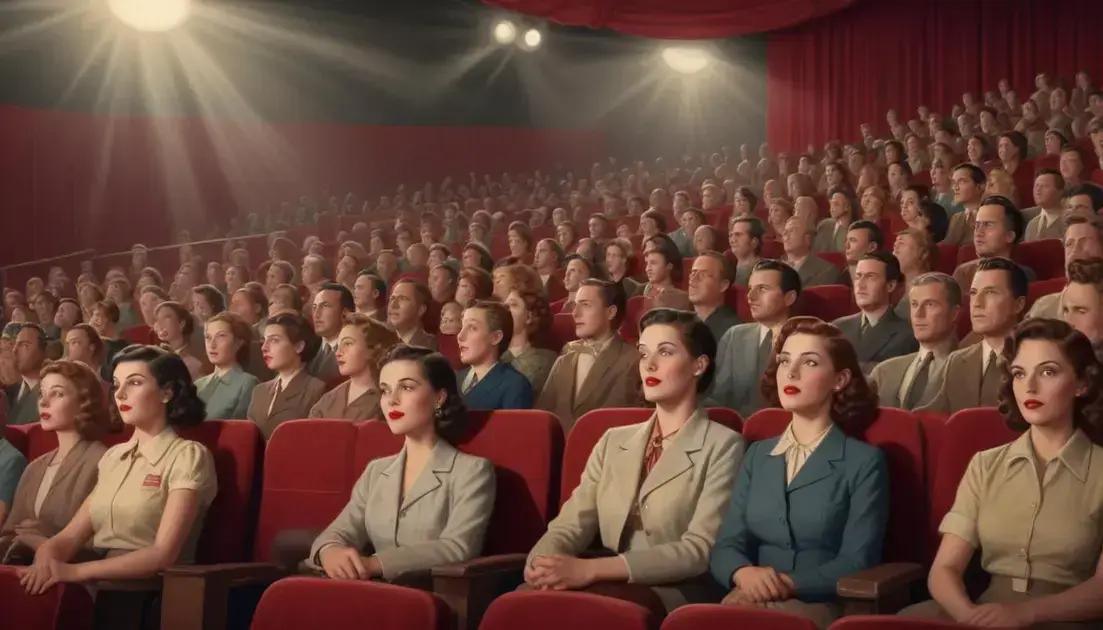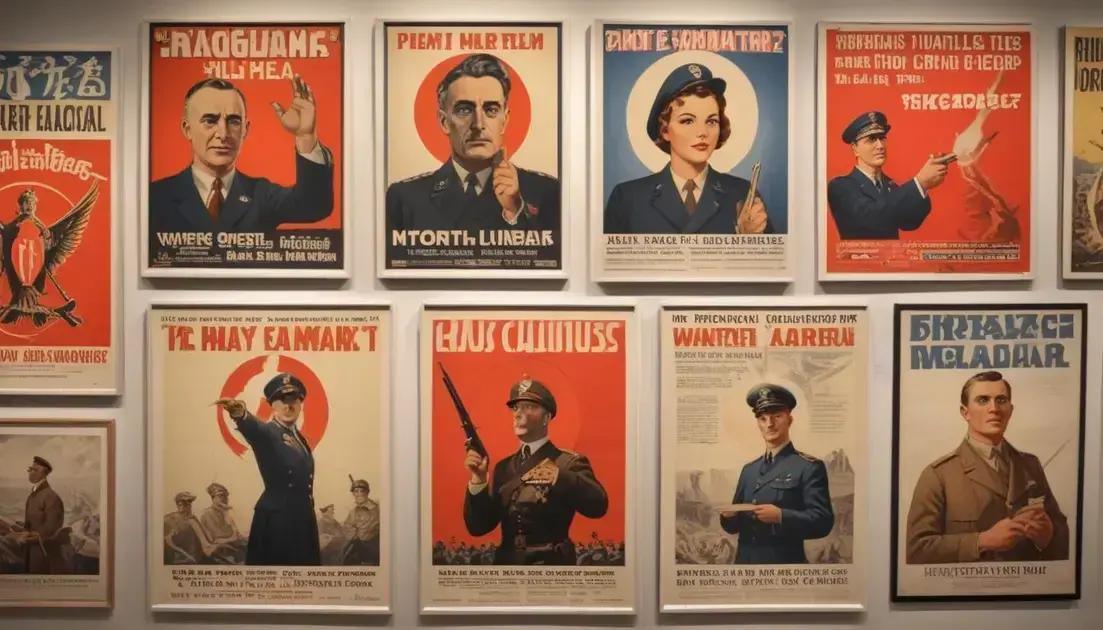
How cinema became a tool of propaganda
Propaganda in modern media significantly influences public opinion through social media, targeted advertising, and the role of influencers. These methods enable rapid message dissemination, shaping how audiences perceive various issues. It’s essential for viewers to remain aware of these influences and critically assess the content they consume to protect against misinformation and manipulation in today’s digital landscape.
Propaganda isn’t just a buzzword; it’s a cinematic tool that has shaped perceptions across generations. Ever wondered how films influence our beliefs?
The historical context of cinematic propaganda
Cinematic propaganda has roots that go back over a century. The early days of film gave filmmakers a chance to tell stories, but also to persuade. Some films were made to show patriotic themes, especially during wars.
The Birth of Government Films
Governments realized the power of film to shape public opinion. During World War I, movies were created to encourage enlistment and boost morale. These films often showcased brave soldiers and heroic acts.
The Great Depression and Beyond
During the Great Depression, films aimed to inspire hope. They featured strong characters overcoming struggles. These stories lifted spirits and provided escapism for troubled audiences.
The Rise of Propaganda in World War II
World War II saw a huge rise in propaganda films. Governments produced films to justify their actions, and encourage support at home. Movies like Why We Fight educated the public on the war’s importance.
Hollywood’s Role
Hollywood wasn’t just about fun; it played a key part, too. Big studios made movies that supported the war effort. They featured messages promoting national unity and sacrifice.
Cold War and Political Messaging
As tensions rose during the Cold War, films shifted to reflect those fears. Movies depicted the fight against communism, promoting American values. This tactic aimed to unite the nation against a common enemy.
The Legacy of Propaganda
Today, the legacy of these films can still be seen. Filmmakers continue to use emotional storytelling to persuade. Understanding this history helps us recognize the impact cinema has on society.
The emotional appeal in film
Films have a unique way of stirring our feelings. The emotional appeal in film can connect us to stories on a personal level. This connection is what keeps us engaged with the characters and the plot.
Creating Relatable Characters
Writers create characters that feel real and relatable. When we see their struggles, we often see parts of ourselves. This makes us care about what happens to them.
Using Music for Motivation
Music plays a key role in setting the mood. The right soundtrack can lift our spirits or make us feel sad. This enhances our emotional experience while watching a film.
Imagery and Visual Effects
Powerful imagery can evoke strong feelings too. Visual effects enhance the story and can leave us in awe. Filmmakers use colors and lighting to create desired moods.
Stories of Love and Loss
Many movies explore themes of love, loss, and friendship. These universal topics resonate with audiences. They make us laugh, cry, and feel deeply.
Viewer Reactions and Reflections
Our reactions to emotional scenes often reflect our own experiences. This connection makes films impactful. It invites us to reflect on our lives and relationships.
The Lasting Impact of Emotional Stories
Films can leave lasting impressions. When we resonate with the emotions presented, we remember them long after the credits roll. The emotional appeal in film is what makes us return to our favorite stories.
Key films that exemplify propaganda
Certain films stand out as clear examples of propaganda. These movies were designed to influence and persuade audiences. Understanding them helps us see how cinema shapes thoughts.
1. The Birth of a Nation
This 1915 film is often seen as one of the first feature-length films. It portrays a biased view of the Civil War and Reconstruction. The film aims to glorify the Ku Klux Klan, showing the power of film in shaping historical narratives.
2. Why We Fight
Produced during World War II, this series of films aimed to explain U.S. involvement. It highlighted the threat of fascism and promoted the war effort. The series used strong visuals and emotive storytelling to rally support.
3. Triumph of the Will
This infamous Nazi propaganda film showcases a 1934 rally in Nuremberg. Directed by Leni Riefenstahl, it glorifies Adolf Hitler and the Nazi Party. The film illustrates how visuals can create powerful propaganda.
4. Reefer Madness
Originally released in 1936, this film aimed to scare audiences by linking marijuana to violence and crime. Its sensational approach turned it into an unintentional comedy over time. It shows how fear can manipulate public perception.
5. Wag the Dog
This modern film explores the idea of creating a fake war to distract the public from scandals. It highlights how media can be used to shape narratives for political gain. The film satirizes the power of propaganda in contemporary politics.
The Impact of Propaganda Films
These films not only entertained but also aimed to persuade. They shaped public opinion during their time and continue to spark discussions today. Their messages remind us to critically evaluate what we see on screen.
The impact of film on public opinion
Film has a powerful impact on public opinion. Movies can shape how we think about different issues. They often reflect society’s values and beliefs.
Emotional Connection
Films create strong emotional connections. We relate to characters and their stories. This connection can influence our views and beliefs.
Shaping Perceptions
Films often highlight certain perspectives. They can show us situations in a new light. This can shift how we see various topics, like race, gender, and politics.
Documentaries and Real Stories
Documentaries play a crucial role in informing the public. They bring real issues to light. Films like Blackfish and 13th show how powerful storytelling can raise awareness and spark conversations.
Entertainment vs. Reality
People sometimes struggle to separate entertainment from reality. When films portray events or groups in specific ways, they can reinforce stereotypes or biases. This can lead to misconceptions among viewers.
Pop Culture Influence
Popular films often influence culture and trends. They can inspire movements and change. For example, films about social issues can motivate people to take action.
Long-lasting Effects
The impact of film on public opinion is often long-lasting. Even years after release, films can shape conversations and attitudes. Understanding this influence helps us be more critical viewers.
Modern implications of propaganda in media
Modern media has transformed how propaganda is created and shared. Today, digital platforms allow messages to spread quickly and widely. This makes it easier for propaganda to reach large audiences.
Social Media’s Role
Social media plays a key role in modern propaganda. Platforms like Facebook and Twitter can amplify messages in real time. Users often share content without verifying facts, which can spread misinformation.
Targeted Advertising
With targeted advertising, messages reach specific groups. Companies and political groups can tailor ads to appeal to certain beliefs. This raises questions about ethical use and manipulation of audience opinions.
Influencer Impact
Influencers can sway public perception through their platforms. When influencers promote products or ideas, their followers may trust them. This creates a new form of modern propaganda that’s hard to trace.
Documenting Misinformation
The rise of fake news highlights the importance of media literacy. Many people fall for misleading headlines and false information. Fact-checking sources are essential for combating misinformation.
Policy and Regulation
Governments are starting to respond to the threat of propaganda in media. Regulations around advertising and disclosures are being discussed. These efforts aim to promote transparency and protect consumers.
Long-term Effects
The implications of modern propaganda are far-reaching. They can shape political views, consumer habits, and societal norms. Understanding how propaganda functions today is essential for informed citizenship.
Conclusion
In conclusion, understanding the impact of propaganda in media is crucial today. With platforms like social media spreading information quickly, we must be aware of how messages influence us. It’s important to think critically about what we see and share online.
We also need to recognize how targeted advertising and influencers can shape our opinions. By being aware of these tactics, we can protect ourselves from misinformation and manipulation. The key to navigating modern media lies in being informed and questioning the sources we trust.
As technology evolves, so does the power of propaganda. How we respond to it will define our ability to think independently and engage as informed citizens. Staying educated about these issues is essential for a healthy society.


